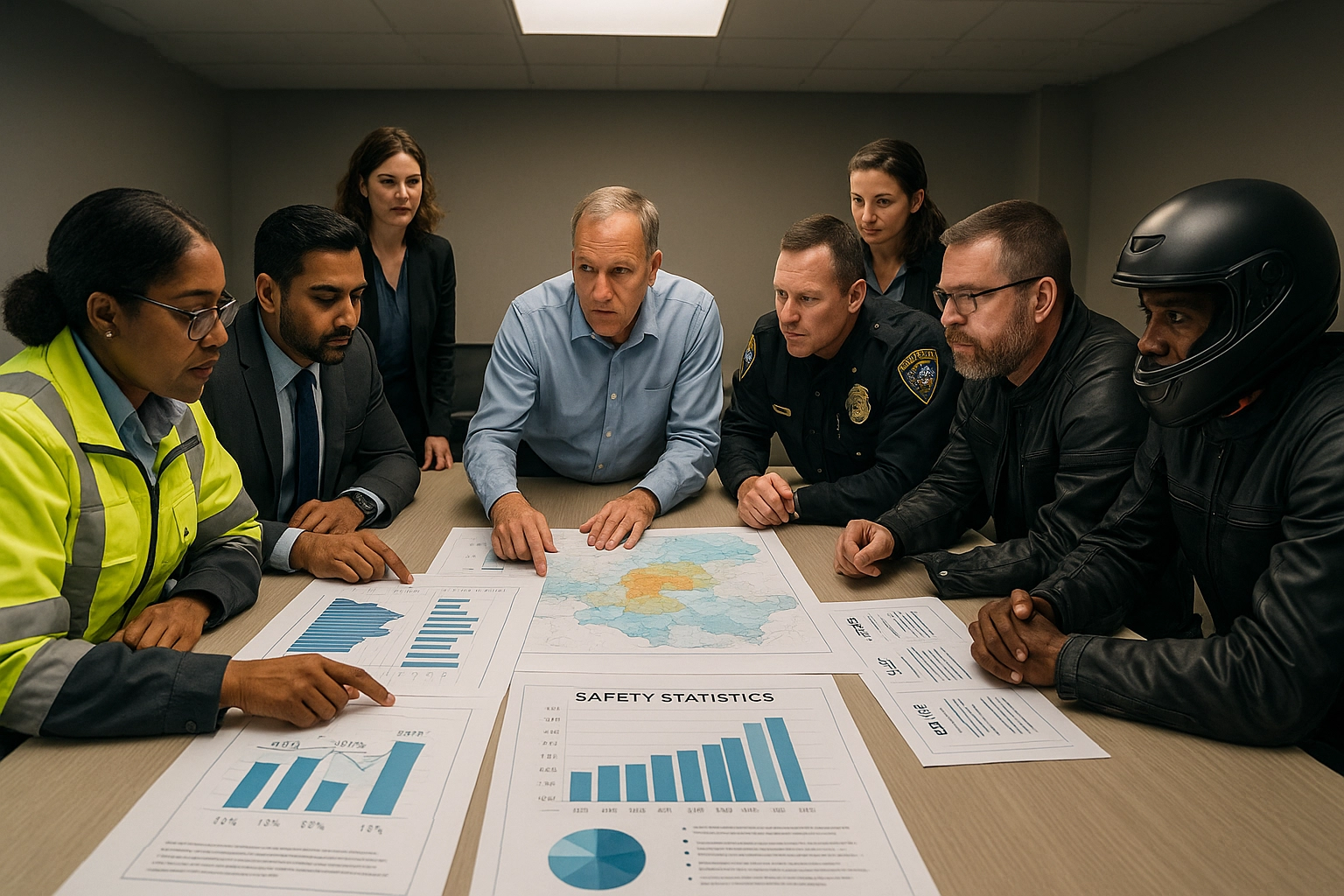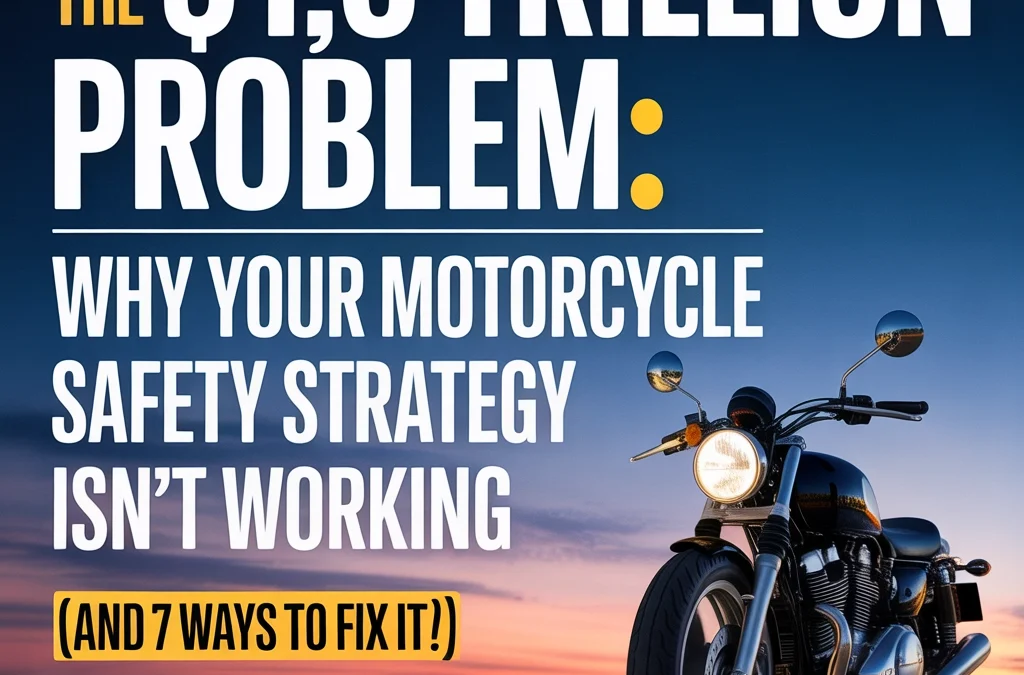Quick Answer: The $1.8 trillion motorcycle safety problem stems from fragmented approaches, outdated messaging, and lack of stakeholder coordination. Current strategies fail because they focus on individual blame rather than systemic solutions. Fix it through data-driven campaigns, multi-agency collaboration, technology integration, targeted demographics, visibility improvements, education overhauls, and measurable accountability systems.
Every year, families lose loved ones to motorcycle crashes that could have been prevented. Every year, taxpayers spend billions on emergency response, medical care, and infrastructure repairs. And every year, safety officials scratch their heads wondering why the numbers keep climbing despite their best efforts.
The reality is stark: motorcycle fatality rates in 2023 reached 31.39 deaths per 100 million vehicle miles traveled, making motorcycling nearly 28 times more dangerous than driving a passenger car. With 6,335 motorcyclists killed in 2023 alone, representing 15% of all traffic fatalities, we're looking at a crisis that demands immediate, coordinated action.
But here's the trillion-dollar question: Why do well-intentioned safety campaigns keep failing to move the needle?
The Real Cost of Failed Safety Strategies

The economic impact extends far beyond the immediate tragedy of lost lives. When we calculate medical costs, lost productivity, property damage, emergency response expenses, and long-term care needs, motorcycle crashes drain approximately $1.8 trillion annually from our economy. Florida alone spends $12 billion yearly on motorcycle-related medical and emergency response costs.
These aren't just statistics on a spreadsheet. They represent real families facing bankruptcy from medical bills, real communities losing productive members, and real taxpayers funding the consequences of preventable crashes.
Yet despite decades of awareness campaigns, helmet laws, and safety initiatives, the problem persists. Why?
Why Current Motorcycle Safety Strategies Keep Failing
The Blame Game Approach: Most safety campaigns focus on lecturing riders about their choices rather than addressing systemic issues. When 36% of motorcycle fatalities involve left-turn collisions, the problem isn't just rider behavior – it's driver awareness and infrastructure design.
One-Size-Fits-All Messaging: A 22-year-old sport bike rider and a 55-year-old touring enthusiast face completely different risk factors, yet they receive identical safety messages. This generic approach fails to resonate with specific demographics.
Lack of Data Integration: Safety agencies operate in silos, collecting data but failing to share actionable insights across departments. Police reports, hospital records, and insurance claims rarely get analyzed together for comprehensive pattern recognition.
Technology Lag: While motorcycles incorporate advanced safety features like ABS, traction control, and blind-spot monitoring, safety campaigns still rely on 1980s messaging about "watching for motorcycles."
Insufficient Stakeholder Coordination: Motorcycle manufacturers, rider education programs, insurance companies, and government agencies all work on safety initiatives independently, creating redundant efforts and missed opportunities for amplified impact.

7 Evidence-Based Ways to Fix Your Motorcycle Safety Strategy
1. Implement Data-Driven Campaign Targeting
Stop guessing about what works. Florida's success in reducing helmet-less fatalities from 52% to 48% came from analyzing crash data by age, location, and circumstances, then crafting specific messages for high-risk scenarios.
Use crash analytics to identify your area's primary risk factors. If speeding accounts for 35% of fatalities in your region, develop campaigns that address speed management specifically for motorcyclists, not generic "slow down" messages.
Action Step: Partner with your state's DOT to access granular crash data and identify the top three contributing factors in your jurisdiction.
2. Create Multi-Agency Collaboration Frameworks
Establish formal partnerships between law enforcement, emergency medical services, rider education programs, and motorcycle dealerships. When everyone shares the same data and objectives, safety messages become consistent and reinforcing rather than contradictory.
The most effective safety initiatives involve motorcycle manufacturers partnering with safety agencies to integrate education directly into the purchase process. New riders receive comprehensive safety information at the moment they're most motivated to learn.
Action Step: Host quarterly stakeholder meetings with all motorcycle safety partners to share data, coordinate messaging, and eliminate duplicated efforts.
3. Integrate Smart Technology Solutions
Modern motorcycles can communicate with infrastructure systems to provide real-time hazard alerts. Instead of fighting technology, embrace it. Develop apps that alert riders to high-crash intersections, weather conditions, or construction zones in real-time.
Partner with GPS manufacturers to include motorcycle-specific routing that avoids high-crash corridors during peak danger times.
Action Step: Pilot a smartphone app integration that provides location-based safety alerts for your highest-crash intersections.

4. Target Demographics with Precision Messaging
Young riders (18-29) crash differently than experienced riders (45+). Create age-specific campaigns that address actual risk behaviors rather than assumed ones. Young riders need information about protective gear and skill development. Experienced riders need reminders about complacency and physical limitations.
Weekend Warriors: Target recreational riders with Friday afternoon social media campaigns about route planning and group riding safety.
Daily Commuters: Focus on visibility, lane positioning, and defensive riding during peak traffic hours.
Action Step: Develop three distinct campaign tracks based on primary riding purpose: recreation, commuting, and touring.
5. Revolutionize Visibility Initiatives
Move beyond "Start Seeing Motorcycles" bumper stickers. Install LED strips at intersection approaches that flash when motorcycles are detected. Implement daytime running light requirements for all motorcycles.
Partner with automotive manufacturers to improve vehicle blind-spot monitoring systems specifically for motorcycle detection.
Action Step: Pilot smart intersection technology at your three highest motorcycle crash locations.
6. Overhaul Rider Education Requirements
Current motorcycle licensing tests focus on basic control skills but ignore real-world hazard recognition. Implement mandatory scenario-based training that simulates actual crash circumstances.
Require ongoing education for license renewal, similar to continuing education requirements in professional fields. Make advanced rider courses accessible and affordable through insurance discounts and government subsidies.
Action Step: Advocate for licensing reform that includes hazard perception testing and requires refresher courses every five years.
7. Establish Measurable Accountability Systems
Create specific, measurable goals with quarterly reporting requirements. Track leading indicators (helmet usage rates, training completion, technology adoption) alongside lagging indicators (crash rates, fatality statistics).
Hold stakeholders accountable with public reporting dashboards that show progress toward safety goals. Celebrate successes and identify gaps in real-time.
Action Step: Develop a public dashboard showing your region's motorcycle safety metrics with quarterly updates and year-over-year comparisons.
The Path Forward Starts Now

Motorcycle safety isn't just about individual responsibility – it's about creating systems that make safe riding the easy choice. When we coordinate efforts, share data, and focus on evidence-based solutions rather than feel-good messaging, we can dramatically reduce the human and economic toll of motorcycle crashes.
The $1.8 trillion annual cost of motorcycle crashes represents more than economic loss. It represents missed opportunities, broken families, and preventable tragedies. But it also represents the scale of impact possible when we get safety strategies right.
Every stakeholder in the motorcycle safety ecosystem – from manufacturers to safety agencies to riders themselves – has a role in implementing these solutions. The question isn't whether we can afford to make these changes. The question is whether we can afford not to.
Ready to revolutionize your motorcycle safety strategy? Contact Ride Fear Free at www.RideFearFree.net or call our AI Receptionist at +1 (970) 693-4854. Connect with Dan Kost, CEO, on LinkedIn to discuss implementing data-driven safety solutions in your community.
Share this post: Help spread evidence-based motorcycle safety by sharing on LinkedIn | Facebook | X | Instagram
What's your experience with motorcycle safety initiatives in your area? Comment below with your thoughts and share this post to help other safety professionals discover these evidence-based solutions.
Tags: #Motivation #Branding #Strategy #Marketing #AdvertisingAndMarketing #DigitalMarketing #Innovation #Sports #MotorcycleSafety #TrafficSafety #DataDriven #PublicSafety #RiderEducation #CrashPrevention

